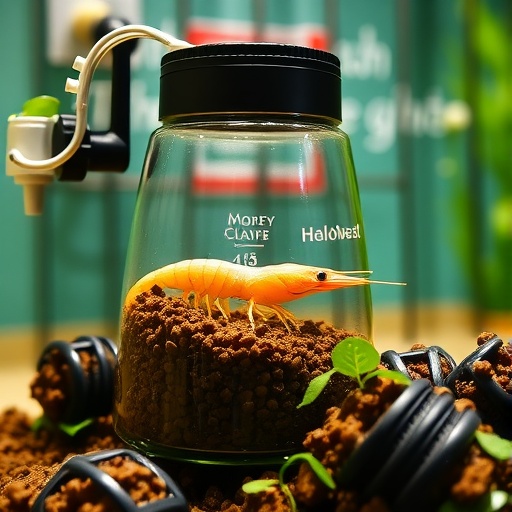Researchers at the University of Sharjah have unveiled a remarkable innovation that promises to revolutionize how we address two critical global challenges: the disposal of seafood waste and the pressing need for efficient carbon capture technologies. This breakthrough involves transforming shrimp waste, a byproduct typically discarded by the seafood industry, into a valuable activated carbon product that can capture carbon dioxide (CO₂) with impressive efficiency. The implications of this discovery extend far beyond environmental sustainability; they also represent a step toward a circular economy where waste is reimagined as a resource.
The seafood industry generates an astonishing amount of waste annually, with shrimp, lobster, and crab processing producing around eight million tons of discarded material. Much of this waste is left to decompose, contributing to environmental pollution. However, the team led by Dr. Haif Al-Jomard has pioneered a method that not only mitigates waste but also converts it into a high-performance material with significant industrial applications. By leveraging both thermal and chemical processes, they have developed a technology that transforms shrimp shells, heads, and intestinal tracts into a functional carbon product.
The research process begins with the meticulous collection of shrimp waste. In this instance, the shrimp were sourced from Souq Al Jubail in Sharjah, UAE, and originally harvested in Oman. Ensuring a clean and suitable feedstock, the waste is first carefully washed and air-dried before undergoing the subsequent stages of processing. The first step in their innovative approach is pyrolysis, a thermochemical decomposition process that occurs in the absence of oxygen. This step effectively breaks down the organic materials into biochar, a type of charcoal with numerous beneficial properties.
Subsequent to pyrolysis, the biochar undergoes a chemical activation process, which is crucial for enhancing its surface area and porosity. This is accomplished through the use of acid treatment, which cleans the material and creates functional groups that increase its ability to adsorb gases. Following this activation, ball milling further improves its texture and disperses the activated carbon into finer particles, yielding a product that is remarkably effective at capturing CO₂.
The activated carbon produced through this novel method exhibits not only a high capacity for CO₂ adsorption but also long-term stability across numerous adsorption-desorption cycles—essential traits for any material intended for industrial carbon capture applications. As articulated by Dr. Al-Jomard, this achievement positions the carbon derived from shrimp waste as a promising candidate for addressing the urgent demand for effective carbon capture technologies in various sectors, including power generation and petrochemicals.
The research findings, published in the esteemed journal Nanoscale, expand on the environmental advantages of utilizing shrimp waste. Not only does this approach tackle the critical issue of seafood waste management, but it also supports global initiatives aimed at reducing greenhouse gas emissions. The ability to convert a problematic waste stream into a valuable resource aligns perfectly with the principles of sustainability and environmental stewardship that are increasingly guiding modern scientific research.
Moreover, the utility of activated carbon extends beyond carbon capture. The material derived from shrimp waste is soluble in water, making it suitable for applications in air and water purification, solvent recovery, gold extraction, and even medical uses. Its versatility represents a strategic opportunity to diversify the economic benefits of shrimp fishing ventures while simultaneously addressing environmental concerns. The potential applications of this innovative product illustrate a fertile ground for further research and development.
The researchers emphasize that their method of converting shrimp waste into activated carbon epitomizes the essence of the circular economy—minimizing waste, optimizing resource use, and maximizing value from by-products. Each step of the treatment process enhances the chemical and physical characteristics of the activated carbon, turning an environmentally detrimental waste product into an efficient, high-value resource. This paradigm shift not only signifies a practical solution to the challenges associated with seafood waste but also contributes significantly to a sustainable future.
Professor Chaouki Ghenai, a co-author of the study and an expert in Sustainable and Renewable Energy at the University of Sharjah, highlighted the economic impacts of this innovative approach. He noted that producing activated carbon from discarded shrimp waste offers a cost-effective pathway, transforming a problematic waste issue into a valuable and ecologically safe product with widespread applications. This dual focus on environmental sustainability and economic practicalities further enhances the attractiveness of the research.
In summary, this pioneering work illustrates a significant stride towards transforming shrimp waste into a beneficial resource capable of addressing pressing environmental challenges. The researchers not only provide a solution for managing seafood waste but also establish a promising foundation for innovative carbon capture technologies. The methodologies developed in this study have implications that ripple out into various scientific fields, encouraging a rethinking of how we approach waste management and resource utilization.
As the world grapples with the realities of climate change, the importance of sustainable practices and innovations cannot be overstated. The approach taken by the University of Sharjah researchers serves as both a model and an inspiration for future research endeavors aimed at finding solutions to environmental crises through innovation and scientific exploration. Their findings reaffirm the belief that where there is a challenge, there also lies an opportunity for advancement and change.
Subject of Research:
Article Title: Activated carbon derived from shrimp waste enhanced by ball milling: a green solution for CO2 capture and waste valorization
News Publication Date: 4-Jun-2025
Web References: Nanoscale Journal
References: DOI 10.1039/D5NR00725A
Image Credits: Haif Al-Jomard / University of Sharjah
Keywords
Environmental sciences, activated carbon, carbon capture, waste valorization, circular economy.
Tags: activated carbon productioncarbon dioxide capture efficiencycircular economy innovationseco-friendly carbon captureenvironmental sustainability solutionsindustrial applications of shrimp wasteseafood byproduct utilizationseafood industry waste managementshrimp waste recyclingsustainable carbon capture technologiesUniversity of Sharjah research advancementswaste transformation processes





